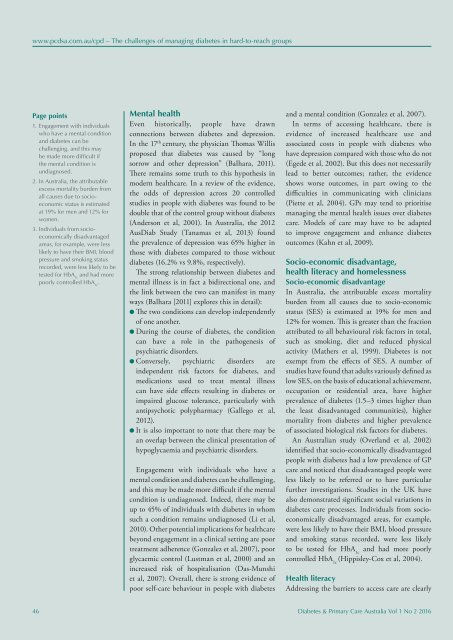DPCA 1-2 full issue
You also want an ePaper? Increase the reach of your titles
YUMPU automatically turns print PDFs into web optimized ePapers that Google loves.
www.pcdsa.com.au/cpd – The challenges of managing diabetes in hard-to-reach groups<br />
Page points<br />
1. Engagement with individuals<br />
who have a mental condition<br />
and diabetes can be<br />
challenging, and this may<br />
be made more difficult if<br />
the mental condition is<br />
undiagnosed.<br />
2. In Australia, the attributable<br />
excess mortality burden from<br />
all causes due to socioeconomic<br />
status is estimated<br />
at 19% for men and 12% for<br />
women.<br />
3. Individuals from socioeconomically<br />
disadvantaged<br />
areas, for example, were less<br />
likely to have their BMI, blood<br />
pressure and smoking status<br />
recorded, were less likely to be<br />
tested for HbA 1c<br />
and had more<br />
poorly controlled HbA 1c<br />
.<br />
Mental health<br />
Even historically, people have drawn<br />
connections between diabetes and depression.<br />
In the 17 th century, the physician Thomas Willis<br />
proposed that diabetes was caused by “long<br />
sorrow and other depression” (Balhara, 2011).<br />
There remains some truth to this hypothesis in<br />
modern healthcare. In a review of the evidence,<br />
the odds of depression across 20 controlled<br />
studies in people with diabetes was found to be<br />
double that of the control group without diabetes<br />
(Anderson et al, 2001). In Australia, the 2012<br />
AusDiab Study (Tanamas et al, 2013) found<br />
the prevalence of depression was 65% higher in<br />
those with diabetes compared to those without<br />
diabetes (16.2% vs 9.8%, respectively).<br />
The strong relationship between diabetes and<br />
mental illness is in fact a bidirectional one, and<br />
the link between the two can manifest in many<br />
ways (Balhara [2011] explores this in detail):<br />
l The two conditions can develop independently<br />
of one another.<br />
l During the course of diabetes, the condition<br />
can have a role in the pathogenesis of<br />
psychiatric disorders.<br />
l Conversely, psychiatric disorders are<br />
independent risk factors for diabetes, and<br />
medications used to treat mental illness<br />
can have side effects resulting in diabetes or<br />
impaired glucose tolerance, particularly with<br />
antipsychotic polypharmacy (Gallego et al,<br />
2012).<br />
l It is also important to note that there may be<br />
an overlap between the clinical presentation of<br />
hypoglycaemia and psychiatric disorders.<br />
Engagement with individuals who have a<br />
mental condition and diabetes can be challenging,<br />
and this may be made more difficult if the mental<br />
condition is undiagnosed. Indeed, there may be<br />
up to 45% of individuals with diabetes in whom<br />
such a condition remains undiagnosed (Li et al,<br />
2010). Other potential implications for healthcare<br />
beyond engagement in a clinical setting are poor<br />
treatment adherence (Gonzalez et al, 2007), poor<br />
glycaemic control (Lustman et al, 2000) and an<br />
increased risk of hospitalisation (Das-Munshi<br />
et al, 2007). Overall, there is strong evidence of<br />
poor self-care behaviour in people with diabetes<br />
and a mental condition (Gonzalez et al, 2007).<br />
In terms of accessing healthcare, there is<br />
evidence of increased healthcare use and<br />
associated costs in people with diabetes who<br />
have depression compared with those who do not<br />
(Egede et al, 2002). But this does not necessarily<br />
lead to better outcomes; rather, the evidence<br />
shows worse outcomes, in part owing to the<br />
difficulties in communicating with clinicians<br />
(Piette et al, 2004). GPs may tend to prioritise<br />
managing the mental health <strong>issue</strong>s over diabetes<br />
care. Models of care may have to be adapted<br />
to improve engagement and enhance diabetes<br />
outcomes (Kahn et al, 2009).<br />
Socio-economic disadvantage,<br />
health literacy and homelessness<br />
Socio-economic disadvantage<br />
In Australia, the attributable excess mortality<br />
burden from all causes due to socio-economic<br />
status (SES) is estimated at 19% for men and<br />
12% for women. This is greater than the fraction<br />
attributed to all behavioural risk factors in total,<br />
such as smoking, diet and reduced physical<br />
activity (Mathers et al, 1999). Diabetes is not<br />
exempt from the effects of SES. A number of<br />
studies have found that adults variously defined as<br />
low SES, on the basis of educational achievement,<br />
occupation or residential area, have higher<br />
prevalence of diabetes (1.5–3 times higher than<br />
the least disadvantaged communities), higher<br />
mortality from diabetes and higher prevalence<br />
of associated biological risk factors for diabetes.<br />
An Australian study (Overland et al, 2002)<br />
identified that socio-economically disadvantaged<br />
people with diabetes had a low prevalence of GP<br />
care and noticed that disadvantaged people were<br />
less likely to be referred or to have particular<br />
further investigations. Studies in the UK have<br />
also demonstrated significant social variations in<br />
diabetes care processes. Individuals from socioeconomically<br />
disadvantaged areas, for example,<br />
were less likely to have their BMI, blood pressure<br />
and smoking status recorded, were less likely<br />
to be tested for HbA 1c<br />
and had more poorly<br />
controlled HbA 1c<br />
(Hippisley-Cox et al, 2004).<br />
Health literacy<br />
Addressing the barriers to access care are clearly<br />
46 Diabetes & Primary Care Australia Vol 1 No 2 2016


